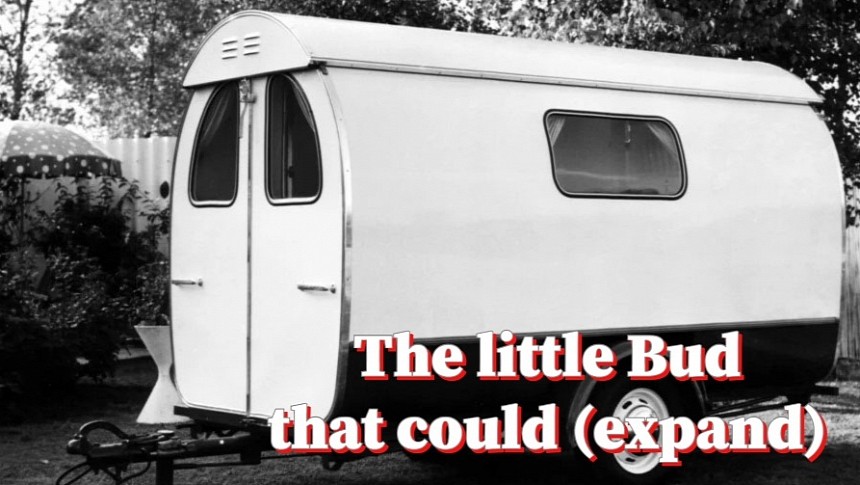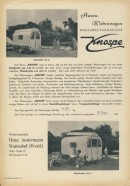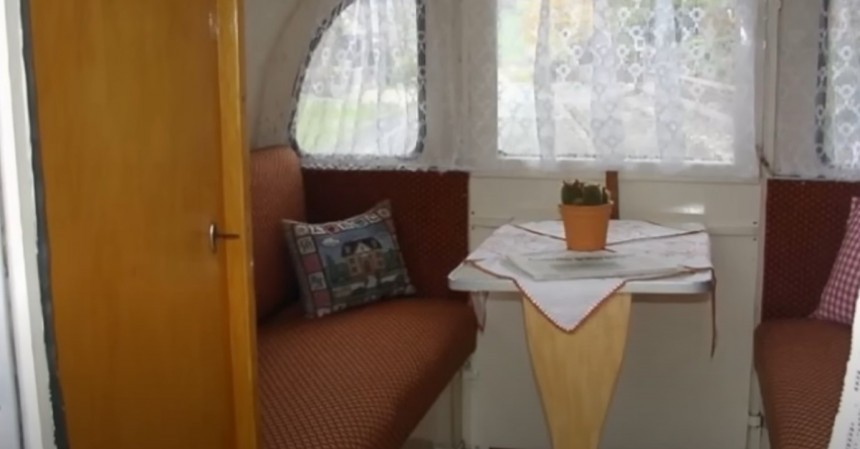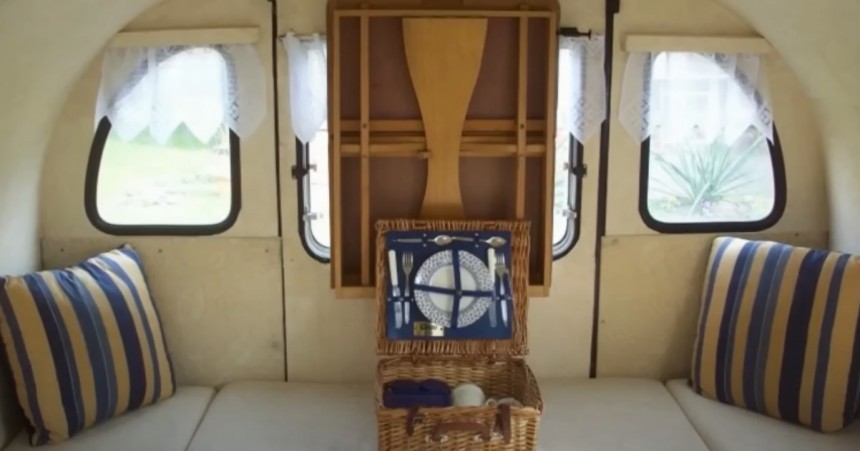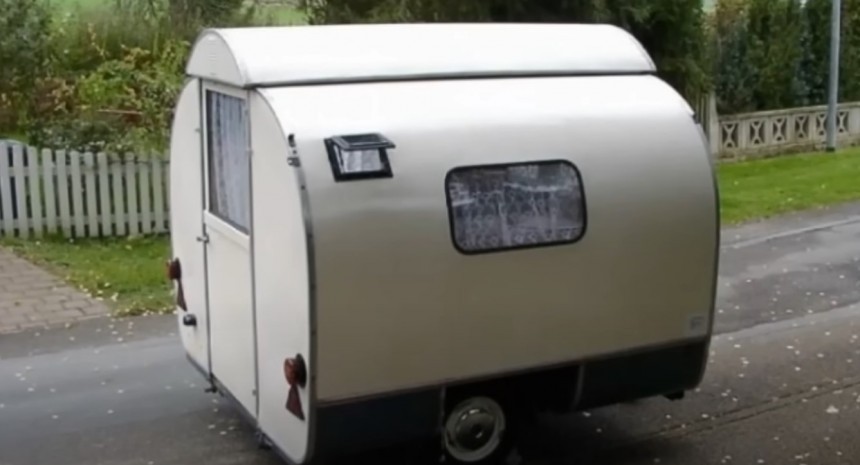Common sense and every wise grandma out there will tell you you can’t have it all. More to the point, you can’t have a luxury RV for family vacations and a work trailer for the rest of the time simultaneously. But that’s where Bud will tell you differently.
Bud is Knospe by its original name, or the Austermann Knospe Wohnwagen for the full name. It’s a now-iconic travel trailer that boasted a very unique ability for RVs of the time, and even for those of today: a combination of luxury features with the ability to perfectly substitute a lightweight working trailer. After all, you can only have so much luxury and vacations: you’re working most of the days, to be able to afford time-off on vacation.
The Knospe was born, like all great inventions, out of necessity, way back in the 1950s, when two men went out camping and ended the day by looking at the rain seep in through their tent walls, drenching everything out. Those men, Heinz Austerman and Hartmann, would later create a first prototype for a trailer that would keep the rain out, while also offering a compact and lightweight towable with maximized space at camp, and that added versatility.
They called it the Falter I, but since they couldn’t decide on who had designed it so they could bring it into production, they gambled off the rights. Hartmann won and renamed it the Hartmann, while Austermann, a carpenter and designer by trade, improved it further and developed the first unit of what would later become the 430 kg (948 lbs) Knospe. That first unit served as his own RV.
Folding or otherwise expanding trailers were a staple of that era, but what the Knospe brought new to the table was that multi-functionality and the surprising mix of apparently opposing styles. On vacation, this trailer was “the ideal holiday home thanks to its spaciousness and rich equipment,” a luxury apartment on wheels that could sleep an entire family of fou and host a dinner party of eight. During the work week, which was most of the time, it served as a work trailer if you simply removed three of the sections and, of course, the furniture onboard.
In travel mode, the Knospe was just 1.4 meters (4.6 feet) wide, with varying lengths depending on whether you chose the G, the K or the Z2 model. What they all had in common was the single-axle flat trailer underneath, and the ability to expand to 2.15 meters (7 feet) in width at camp, by sliding the side walls outwards with the help of “feather-light” hand cranks.
The interior was quite fancy for the time: a dining area at the rear, with storage-integrating benches and a fold-up table could seat as many as 8 people, and would turn into a king-size bed at night. Brochures mentioned sleeping for four people in this bed, so we’re guessing they meant a family with two small kids.
The front was taken up by a kitchen on the right side and a large wardrobe on the left, with the latter offering hanging racks and extra cupboards. The kitchen included a flush-mounted sink with a 10-liter (2.6-gallon) fresh water tank, a two-burner gas stove, additional storage space, and even a 40-liter (1.4 cubic-foot) fridge. By today’s standards, this setup wasn’t much, but it was the height of comfort for those times.
The Knospe also offered a removable awning, a couple of lights and good ventilation by means of the windows, but more importantly, it offered a compact footprint that allowed for maximum visibility on the road for the driver. That last part explains its initial popularity.
“This caravan satisfies the highest demands in terms of space and comfort,” reads the text on one brochure. “A trailer that leaves nothing to be desired, a ‘proper home’ on wheels.” Finishes included solid wood for the cabinetry, rug on the floor, floral fabrics for the benches and – of course! - frilly curtains on all windows. The word used to describe the styling was “tasteful,” but taste is relative to each decade, so we won’t comment on that.
The Knospe went into production in 1959 and, despite a prohibitive price tag, became such a hit that Austermann would build over 1,000 units until the early ‘60s, when he sold the company off. The Austermann Company didn’t disappear though, but was integrated into the family-owned and still-operational Lord Munsterland Caravan (LMC), but the acquisition marked the end of the Knospe, the little Bud that could.
It is believed that less than 60 or 70 units of this trailer survive today, and half of them aren’t even in working condition. This helped the cute trailer become an icon in its native country, with owners gathering every two years for the “Bud Meeting” at Campingpark Heidewald to show off their renovated Buds and exchange thoughts on ownership.
The Knospe was born, like all great inventions, out of necessity, way back in the 1950s, when two men went out camping and ended the day by looking at the rain seep in through their tent walls, drenching everything out. Those men, Heinz Austerman and Hartmann, would later create a first prototype for a trailer that would keep the rain out, while also offering a compact and lightweight towable with maximized space at camp, and that added versatility.
They called it the Falter I, but since they couldn’t decide on who had designed it so they could bring it into production, they gambled off the rights. Hartmann won and renamed it the Hartmann, while Austermann, a carpenter and designer by trade, improved it further and developed the first unit of what would later become the 430 kg (948 lbs) Knospe. That first unit served as his own RV.
In travel mode, the Knospe was just 1.4 meters (4.6 feet) wide, with varying lengths depending on whether you chose the G, the K or the Z2 model. What they all had in common was the single-axle flat trailer underneath, and the ability to expand to 2.15 meters (7 feet) in width at camp, by sliding the side walls outwards with the help of “feather-light” hand cranks.
The interior was quite fancy for the time: a dining area at the rear, with storage-integrating benches and a fold-up table could seat as many as 8 people, and would turn into a king-size bed at night. Brochures mentioned sleeping for four people in this bed, so we’re guessing they meant a family with two small kids.
The Knospe also offered a removable awning, a couple of lights and good ventilation by means of the windows, but more importantly, it offered a compact footprint that allowed for maximum visibility on the road for the driver. That last part explains its initial popularity.
“This caravan satisfies the highest demands in terms of space and comfort,” reads the text on one brochure. “A trailer that leaves nothing to be desired, a ‘proper home’ on wheels.” Finishes included solid wood for the cabinetry, rug on the floor, floral fabrics for the benches and – of course! - frilly curtains on all windows. The word used to describe the styling was “tasteful,” but taste is relative to each decade, so we won’t comment on that.
It is believed that less than 60 or 70 units of this trailer survive today, and half of them aren’t even in working condition. This helped the cute trailer become an icon in its native country, with owners gathering every two years for the “Bud Meeting” at Campingpark Heidewald to show off their renovated Buds and exchange thoughts on ownership.
